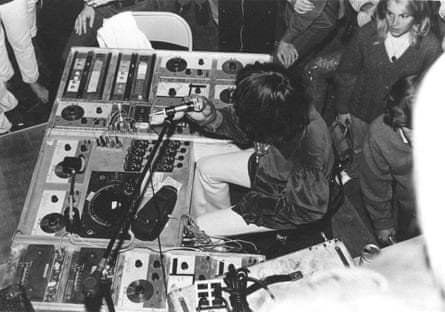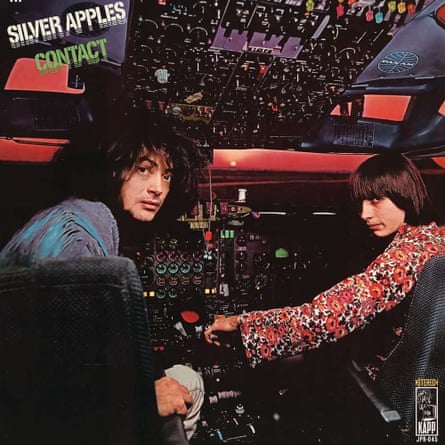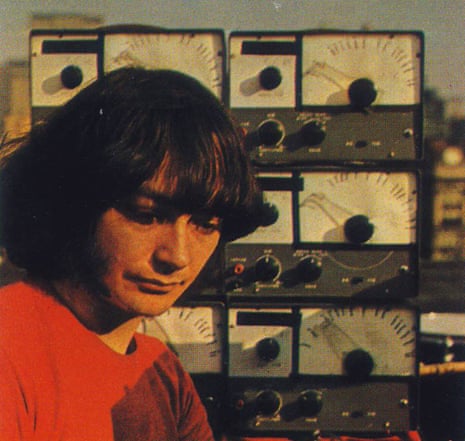In the late 1960s, before Tangerine Dream’s Phaedra became the post-hippy stoner’s soundtrack of choice, before Kraftwerk’s Autobahn instilled the idea that pop could be made entirely using electronics in a generation of musicians’ minds, the synthesiser was still an instrument largely associated with novelty albums and classical music: serialist composers including Milton Babbitt were fond of them; the big electronic hit album of the era was Wendy Carlos’s Switched-On Bach, featuring the Brandenburg Concerto and Air On a G String rendered on a Moog.
In the world of rock music, they existed largely as something to embellish the albums of top-flight bands, decorating a couple of tracks on the Beatles’ Abbey Road and Simon and Garfunkel’s Bookends. The rock artists who jumped in feet-first were a peculiar bunch: there was Lothar and the Hand People, a scrappy folk-rock band intent on using a theremin wherever they could; there was the White Noise, refugees from the BBC Radiophonic Workshop whose 1969 album An Electric Storm blended psychedelic whimsy and punishing experimentalism; there was the United States of America, communists who saw their music as a means of politically radicalising an entire country.
And there was Silver Apples, whose very existence told you something about the air of confusion and suspicion that surrounded synthesisers in rock circles. They had begun their career in New York’s East Village as straightforward rockers called the Overland Stage Electric Band, until – horrified by vocalist Simeon Coxe’s use of an old 1940s oscillator on stage – every member except Coxe and drummer Danny Taylor quit. The duo soldiered on, Coxe eventually compiling his expanding collection of oscillators into something resembling a homemade synthesiser in order to make it easier to transport to gigs. Dubbed “the Simeon”, Coxe played it with his hands, feet, elbows and occasionally his forehead.
The sound they made was visionary. On their eponymous 1968 debut album – no guitars, just vocals and primitive electronics set against Taylor’s rattling drums – you can hear sounds that presage a host of subsequent artists: the simple, hypnotic patterns that stood in for basslines sound remarkably like Suicide; something about the music’s driving relentlessness and the syncopated patterns of Taylor’s playing brings to mind Krautrock; the recordings of radio broadcasts that pepper Program weirdly give it the air of 80s pop’s experiments in sampling, when dropping clips of movie or TV dialogue into songs was considered the last word in forward-thinking production embellishment; confronted by the opening of Oscillations, you would be forgiven for thinking you were listening to Spacemen 3.

Presumably assuming that the duo’s music might find a place in the all-bets-are-off climate of experimentation ushered in by psychedelia, their record label Kapp released a couple of singles but it was a hopeless gesture: Silver Apples’ sound – rough-hewn, chaotic, somehow grimy-feeling – made few concessions to commerciality and absolutely none to an era in which the synthesiser’s primary role was to provide beatific, “far-out” soundscapes on cash-in albums themed around nature or space or the signs of the zodiac. For all the hippy-ish bent of some of the lyrics, in which sea-green serenades awaken you to dream and maidens gather flowers, there was something actively confrontational about the harshness of the music: the atonal bleeps and shrieks that run through Velvet Cave, the ominous atmosphere of Dust. The reaction was understandably divisive. Jimi Hendrix was apparently a fan, but after the Silver Apples supported Blood, Sweat and Tears, the latter band claimed the duo were so awful they’d been forced to vacate the venue during their set. As more than one critic has pointed out, Silver Apples may have had less in common sonically with other synthesiser pioneers than they did with fellow New Yorkers the Velvet Underground, and people weren’t exactly rushing out to buy their albums in 1968 either.

Worse was to come. Silver Apples’ second album, Contact, was even better than their debut, not least because the lyrics now seemed to match their sound more closely: less of the sea-green serenades and flower-gathering maidens, more in the way of surly, garage-punk attitude on You’re Not Foolin’ Me and the fantastic A Pox on You. They should probably have realised that, even though Pan-Am had given them permission to take the cover photo in the cockpit of a commercial aircraft, they wouldn’t be impressed by the rear of the sleeve, which featured the pair sitting amid the wreckage of a plane crash. The effects of the subsequent lawsuit were far-reaching: the album was pulled from sale, a cease-and-desist order was issued on Coxe and Taylor performing live, their equipment was impounded. Silver Apples broke up and Coxe moved to Alabama, finding work as a graphic designer, an ice-cream van driver and a local TV presenter.
It took the best part of 30 years for the band to be rediscovered, but gradually their influence began seeping out among the kind of artists who scoured rare record lists and secondhand bargain bins for inspiration. Stereolab had clearly been listening to them, as had Broadcast. Portishead’s Geoff Barrow was so enamoured that he recorded a loving homage on the band’s third album, the brilliant We Carry On. He would later invite Coxe onstage to perform it with them. He wasn’t the only artist from a different generation who collaborated with the group: having already covered A Pox on You, former Spacemen 3 frontman Sonic Boom released the mini-album A Lake of Tears, on which his other band Spectrum were joined by Coxe.
By then Silver Apples had reformed: such was their cult that the Beastie Boys and Sean Lennon turned up at their first comeback gig; such was the newfound hip cachet of their 60s work that so did Johnny Depp and Kate Moss. Yet a sense of bad luck continued to follow them. Initial gigs featured Coxe and a supporting cast of younger acolytes, but having located his former bandmate – and the tapes of the band’s unfinished third album, eventually released as The Garden in 1998 – the original duo reformed: they lasted three gigs before a 1999 road accident broke Coxe’s neck. After a lengthy recuperation, the duo resumed, but Taylor died of cancer in 2005. Nevertheless, Coxe released a series of new albums under the Silver Apples name: 1998’s Decatur offered an uncompromising, 42-minute-long, beat-less blast of electronics; 2016’s Clinging to a Dream was far softer and more playful than the original band had ever been.
Coxe was unimpressed by fans who felt he should stick to performing old material, pointing out – not unreasonably – that listening to other people’s opinions was never really Silver Apples’ thing: “We stuck to our guns and played what we wanted to play, not what our managers, agents and record label were telling us.” Nor was he beholden to the old-fashioned analogue equipment with which he’d made such an impact. He transferred all his sounds to a sampler, and used that, triggering recordings of Taylor’s drum tracks onstage to recreate the duo’s dynamic after his death. It was operated using buttons and – in a final burst of Heath Robinson eccentricity – a triggering device he’d built out of a PVC pipe and a door hinge. It had to be: despite enjoying a career spanning 50 years, Simeon Coxe had apparently never actually learned to play a keyboard.

